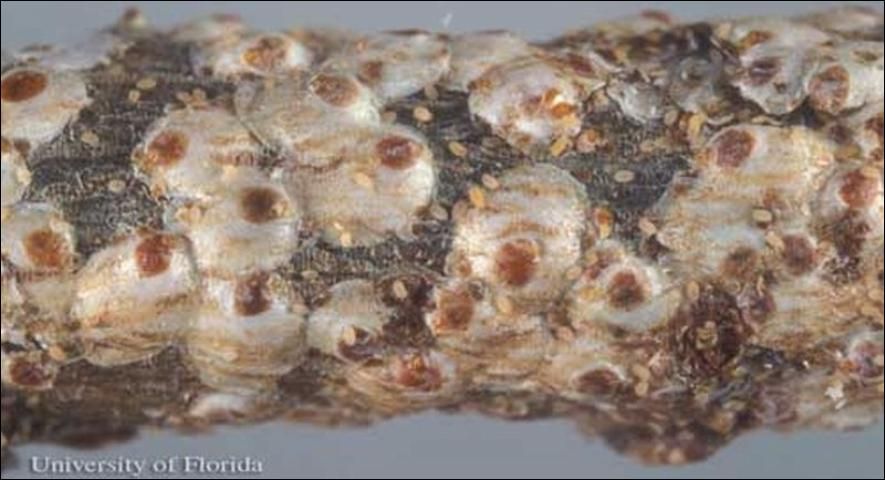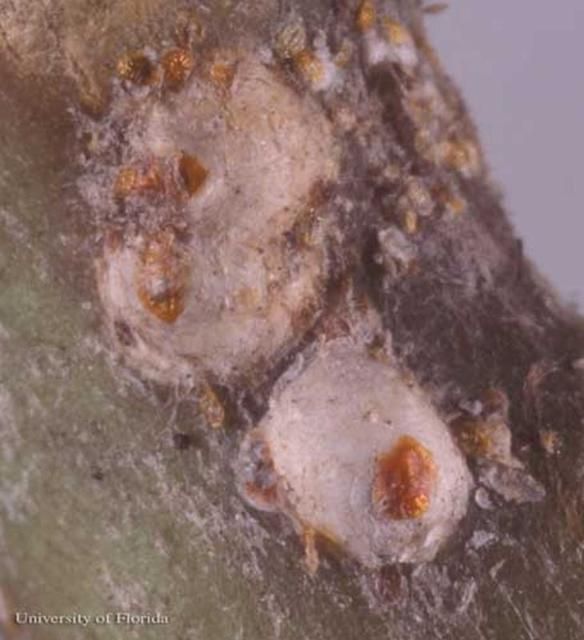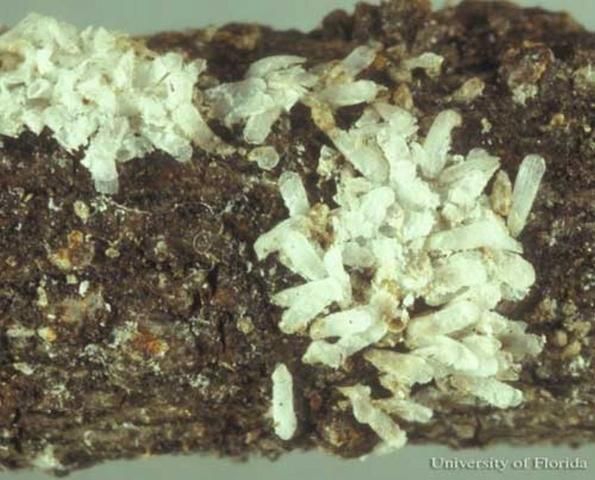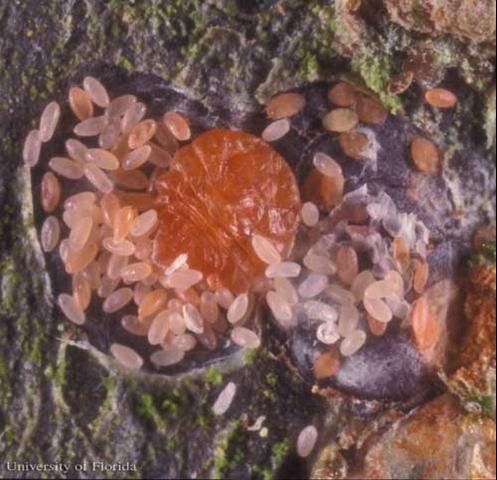White Peach Scale, Pseudaulacaspis pentagona (Targioni) (Insecta: Hemiptera: Diaspididae)
The Featured Creatures collection provides in-depth profiles of insects, nematodes, arachnids and other organisms relevant to Florida. These profiles are intended for the use of interested laypersons with some knowledge of biology as well as academic audiences.
Introduction
White peach scale, Pseudaulacaspis pentagona (Targioni), is believed to have originated in Japan or China, although one report places the point of origin in Italy where it was first described in 1886 by Targioni. This insect is an important economic pest of peach trees as well as woody ornamentals in the southeastern United States. In the early part of this century, white peach scale destroyed numerous peach orchards in Florida and completely decimated a grove of 10,000 peach trees in South Georgia.

Credit: Lyle J. Buss, University of Florida
Distribution
White peach scale is found not only in the United States but is known throughout the world. In other areas it is known by a variety of common names including white scale and West Indian peach scale. In Bermuda, this pest is known as oleander scale because of the massive damage it caused to oleander plants in 1920.
In the United States, it is found primarily in the southeast, although it has been reported as far west as Texas and in northern states up to Maine. Hawaii first reported this pest in 1997 where it endangers the papaya crop. A survey in 2004-2005 found it still limited to the big island (Hawaii). However, the scale has been found on fruit for sale on Oahu. In 2006, an infestation was reported on Kauai (Wood 2009, Wright 2009).
Description
Eggs
Eggs are deposited on the surface of the host plant. They range in color from orange to white indicating female and male offspring respectively. Eggs of an intermediate color may also be evident which can produce offspring of either sex.
Larvae
The larvae will hatch from the egg case within approximately three to four days after being laid. The young crawlers will soon settle on an area of the host plant and insert their stylets into the plant to begin feeding. The larvae will undergo two to five molts, depending on their sex.
Adult Female
The adult female scale is immobile on the host plant. She is covered with a protective shell, which is created by incorporating the cast skins from her previous molts with newly secreted wax from her body glands. She may also gather pieces of bark from the host plant to add to her shell, which then serves as protective camouflage. The appearance of the female is dull white to yellowish in color, oval in shape, with an overall length measuring between 2.0 to 2.5 mm.

Credit: Lyle J. Buss, University of Florida
Adult Male
Males of the white peach scale begin building their armor after their second molt and their covering appears as a long white to yellowish colored shell. The males will molt three more times, eventually emerging as an orange colored adult and living only for a period of approximately 24 hours. Unlike females of this species, adult males possess wings in order to be mobile for mate location. The adult male body length is approximately 0.7 mm with a 1.4 mm wingspan.

Credit: Lyle J. Buss, University of Florida
Life Cycle
The life cycle of the white peach scale depends upon the climate in which it resides. In northern states, such as Pennsylvania, there may be only two generations each year. In the southern states of Virginia, North Carolina, Georgia, and Florida, there are as many as four generations per year.
The adult females of the white peach scale begin laying eggs approximately two weeks after mating and will continue to lay eggs for eight or nine more days. After the female has finished the oviposition or egg-laying process she will soon die. An interesting phenomenon of the egg laying process is that the eggs which are deposited first are orange in color and will become female offspring, while the eggs that are laid later are white and will give rise to male offspring. The average number of eggs produced by each female will vary due to several factors but is primarily influenced by the species of the host plant that is being infested. In Georgia, it was reported that female scales laid an average of 100 eggs when peach trees served as the host plant, while in Florida, an average of 80 eggs were laid on potato plants. The eggs hatch three to four days after being deposited and young crawlers emerge.

Credit: Lyle J. Buss, University of Florida
The male offspring have a tendency to stay near the scaly covering of their mother, sometimes sheltering under her armor. Generally, the females will wander farther away from the mother, which serves to distribute the scale infestation throughout the host plant. The young scales will move about the host plant for up to 12 hours and then settle down to begin feeding. Female white peach scales will undergo two molts before reaching sexual maturity as adults. Males will undergo five molts before reaching adulthood. Once mature, however, the males will live for only one day. To facilitate the mating process, females will release sex pheromone timed to the eclosion of the males. The males are then attracted to the pheromone and are capable of mating with several different females in a short period of time.
Economic Significance
The white peach scale inhabits up to 121 host plants in Florida and can cause major economic damage. Some of the host plants that have been identified are privet, mulberry, paper mulberry, catalpa, and chinaberry. Thousands of dollars are spent each year on the control of this pest as infestation can become significant. The white peach scale will infest the bark, fruit, and leaves of plants, thus making it a "triple threat" to growers.
Management
Predators
In Florida, several predators feed on white peach scale. Primarily, these species are ladybird beetles (Coleoptera: Coccindellidae), and common lacewings (Neuroptera: Chrysopidae). Some gall midges (Diptera: Cecidomyiidae) also attack white peach scale. In 2009, researchers in Hawaii imported a parasitoid wasp, Encarsia diasapidicola, under quarantine. The wasp will be tested under laboratory conditions for white peach scale control.
Chemical
Management of the white peach scale is difficult as the scales protect themselves very effectively with their hard, waxy armor. Control methods are often best directed at the larval or crawler stages, which are the most vulnerable. Traditional methods of control have included various insecticidal oils as well as a number of other pesticides. As insecticide recommendations and regulations are updated yearly, it is advisable to consult a local Cooperative Extension Service office or a pesticide reference guide for current information on control methods for this pest.
Selected References
Bobb ML, Weidhaas JA, Ponton LF. 1973. White peach scale: life History and control studies. Journal of Economic Entomology 66: 1290-1292.
Collins FA, Whitcomb WH. 1975. Natural enemies of the white peach scale Pseudaulacaspis pentagona (Homoptera: Coccoidea), in Florida. Florida Entomologist 58: 15-21.
Duyn JV, Murphey M. 1971. Life history and control of white peach scale, Pseudaulacaspis pentagona (Homoptera: Coccoidea). Florida Entomologist 54: 91-95.
Gossard HA. 1902. Two peach scales. Florida Agricultural Experiment Station Bulletin 61: 492-298.
Hamon AB. 1983. White peach scale, Pseudaulacaspis pentagona (Targ. - Tozz.) (Homoptera: Coccoidea: Diaspididae). Entomology Circular No. 253. Florida Department of Agricultural and Consumer Services. Division of Plant Industry. 2 pp.
McLaughlin JR, Heath RR, Ashley TR. 1990. Periodicity of pheromone release from female white peach scale. Physiological Entomology 15: 193-197.
Stimmel JF. 1982. Seasonal history of the white peach scale, Pseudaulacaspis pentagona (Targ. - Tozz.) (Homoptera: Diaspididae), in northeastern Pennsylvania. Proceedings of the Entomology Society of Washington 84: 128-133.
Wood M. (July 2009). Pesky white peach scale targeted in tropical studies. USDA-ARS News & Events. https://www.ars.usda.gov/news-events/news/research-news/2009/pesky-white-peach-scale-targeted-in-tropical-studies/ (25 February 2022).
Wright MG. (April 2009). News on tropical fruit and nut pests and IPM recommendations. Insect Ecology and Integrated Pest Management Lab, University of Hawaii at Manoa. https://www.ctahr.hawaii.edu/wrightm/extension.htm (25 February 2022).
Yonce CE, Jacklin SW. 1974. Life history of the white peach scale in central Georgia. Journal of the Georgia Entomological Society 9: 213-216.



